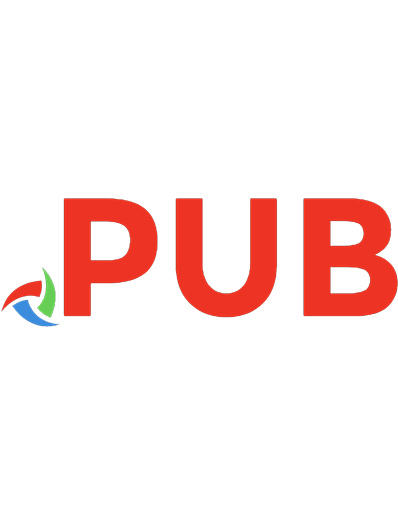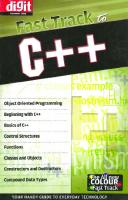Fast Track to C++
334 53 714KB
English Pages [123]
Polecaj historie
Citation preview
Fast Track to
C++ By Team Digit
Credits The People Behind This Book EDITORIAL Robert Sovereign-Smith Assistant Editor Santanu Mukherjee, Supratim Bose, Nilay Agambagis, Bhaskar Sur Writers DESIGN AND LAYOUT Vijay Padaya, U Ravindranadhan Layout Design Rohit Chandwaskar Cover Design
© 9.9 Interactive Pvt. Ltd. Published by 9.9 Interactive No part of this book may be reproduced, stored in a retrieval system or transmitted in any form or by any means without the prior written permission of the publisher. November 2008 Free with Digit. Not to be sold separately. If you have paid separately for this book, please e-mail the editor at [email protected] along with details of location of purchase, for appropriate action.
FAST TRACK
3
CONTENTS
4
Chapter 1
Object Oriented Programming
5
1.1
Basic Concepts
6
1.2
Data Abstraction And Encapsulation
8
1.3
Inheritance
8
1.4
Polymorphism
9
1.5
Applications Of OOP
10
Chapter 2
Beginning with C++
11
2.1
Introduction To C++
11
2.2
Applications of C++
12
2.3
A Simple C++ Program
12
2.4
An Example Of Class In C++
16
Chapter 3
Basics of C++
7
3.1
Program Structure
18
3.2
Variables
21
3.3
Data Types
27
3.4
Constants
28
3.5
Operators
32
3.6
Basic Input/output
38
Chapter 4
Control Structures
4.1
Branching
40
4.2
Looping
50
Chapter 5
Functions
61
5.1
Main Function
61
5.2
Function Prototyping
62
5.3
Call By Reference
66
5.4
Return By Reference
68
5.5
Inline Functions
68
5.6
Function Overloading
69
FAST TRACK
40
CONTENTS Chapter 6
Classes and Objects
72
6.1
Specifying A Class
73
6.2
Defining Member Functions
76
6.3
A C++ Program With Class
77
6.4
Nesting Of Member Functions
79
6.5
Static Member Functions
81
6.6
Friendly Functions
83
Chapter 7
Constructors and Destructors
87
7.1
Introduction
87
7.2
Constructors
88
7.3
Types of Constructors
91
7.4
Constructing Two Dimensional Arrays
97
7.5
Destructors
99
Chapter 8
Compound Data Types
8.1
Arrays
103 103
8.2
Character Sequences
108
8.3
Pointers
110
8.4
Other Data Types
116
FAST TRACK
5
OBJECT ORIENTED PROGRAMMING
C++
I
Object Oriented Programming
O
bject Oriented Programming (OOP) is a programming concept, involving objects and their interactions to design applications and various computer programs. The highlights included within this programming technique are encapsulation, modularity, polymorphism, and inheritance. This concept was not conventionally used in mainstream software development and predominantly came into practice in the early ’90s. These days, most programming languages support OOP. The main reason for this is the need to remove the flaws encountered in the typical procedural approach used in archaic programming through the computing ages. OOP originates way back to the sixties. Over the years, as the hardware and software evolved, quality was often compromised. Analysts and designers were soon looking for ways to address this problem. OOP focuses on data instead of processes, with programs composed of self-sufficient modules (objects) that contain all the information needed for manipulation. ‘Simula’ was the first language to introduce OOP to the programming world. The various terminologies it brought were objects, classes, subclasses, virtual methods, co-routines, garbage collection, and discrete event simulation. The language was also used for physical modelling. However, the first language which was labelled as an ‘Object Oriented’ language was ‘Small Talk’. The highlights of OOP are: ● Emphasis on data rather than the procedure. ● Programs are divided into entities known as objects. FAST TRACK
7
I
OBJECT ORIENTED PROGRAMMING
C++
● Data
structures are designed to characterize the objects. operating on the data of an object are tied together in the data structures. ● Data used is generally hidden and cannot be accessed by external functions. ● Functions help objects to communicate with each other. ● New functions and data can easily be added as per need. ● A bottom up approach is followed during program design. ● Functions
1.1 Basic Concepts Before delving into OOP, it is important to be familiar with its concepts. These include: ● Classes ● Objects ● Dynamic ● Message
Binding passing
Classes Classes are used to implement the concept of Abstract Data Types (ADT). A class is a combination of both properties and methods used to manipulate properties. In fact, a class is a blueprint describing the nature of the data structure. For example, consider the case of the class ‘student’. There are some common properties shared by all students, such as name, roll, class, address, and marks. Similarly, there might be some methods used to manipulate these properties. However, the values of these properties can differ depending in the student. If we want to use the class ‘student’, then we need to create instances of this class, also known as objects. Classes are user-defined data types and behave like a built-in programming language. Objects Objects are the basic runtime entities in an object oriented system. In fact, it is the instance of a class. An object can be a person, place, bank account or even a table of data that the pro-
8
FAST TRACK
C++
OBJECT ORIENTED PROGRAMMING
I
gram needs to handle. Objects may also represent user-defined data such as vectors, time and lists. When a program gets executed, the objects interact by sending suitable messages to one another. For example, any student will be an object in the class ‘student’. Similarly, if we consider a fruit to be a class, then mango, apple, and guava will be objects in this class. Dynamic Binding The term binding refers to linking a procedure call to the code that needs to be executed as a response to this call. Similarly, ‘Dynamic Binding’ or late binding refers to the code that remains unknown until the procedure is called during run time. Dynamic binding is also associated with polymorphism and inheritance. For example, let us consider a procedure called ‘calculation’ declared in a class. Some classes may inherit that class. The definitions (code) associated with the procedure ‘calculation’ are written such that they perform different operations in each derived class. For example, in one class, the code is written for addition, while in another class for subtraction, and so on and so forth. For objects of different classes, the procedure will provide different results and will be unknown till the execution is complete. Message Passing Message passing is the process by which one object sends data to another, or asks the other object to invoke a method. This concept is also known as interfacing in some programming languages. In an object-oriented language, objects communicate with each other by sending and receiving various types of information. The message for an object is related to the request for execution of a procedure, and thus invokes a function in the receiving object, thereby generating the desired result. Message passing also involves specifying the name of the object, the name of the message and the information to be sent. For example,
FAST TRACK
9
I
OBJECT ORIENTED PROGRAMMING
C++
Employee. earnings (name); In the above statement, the employee is regarded as the object, earnings as the message, and name as the information. In addition, the following needs to be mentioned: ● Data
Abstraction and Encapsulation
● Inheritance ● Polymorphism
1.2 Data Abstraction And Encapsulation Data abstraction and Encapsulation are fundamental to OOP. The process of wrapping up data and functions into a single unit is called ‘encapsulation’. In other words, encapsulation hides the functional details of a class from objects that send messages to it. Data is not generally accessible to the outside class and only functions wrapped in the class can access it. Encapsulation is also achieved by specifying the particular class using objects of another class. Abstraction refers to the act of representing essential features and characteristics without detail. Classes use the concept of data abstraction and are known as ‘Abstract Data Types’.
1.3 Inheritance This is another important feature of OOP. By Inheritance, classes can acquire the properties and methods of another class or classes. Inheritance supports hierarchical classification. In other words, the process by which the subclasses inherit the attributes and behaviour of the parent class is termed as ‘Inheritance’. For instance, the class ‘Dog’ may have sub-classes as Spitz,
10
FAST TRACK
OBJECT ORIENTED PROGRAMMING
C++
I
Alsatian, and Golden Retriever. Consider the class ‘Dog’ defines a method called bark() and a property called furColor. Each of its sub-classes (Spitz, Alsatian, and Golden Retriever) will inherit these members. Therefore, the programmer needs to write the code for them just once. Subclasses can also add new members. For instance, take the case of the subclass ‘Alsatian’. It can add another method, say, tremble. C++ also supports multiple inheritance, where a subclass inherits properties from more than one ancestral class.
1.4 Polymorphism A Greek term, Polymorphism is the ability to represent oneself in multiple forms. It helps the programmers to treat derived class members, just like their parent class members. By implementing this concept, one can use an operator to perform different operations depending on the operands used. For instance, if we consider two numbers, the operation ‘addition’ will generate a sum. Similarly, if the operands are strings, then the operation will produce a third string by concatenation. This phenomenon of making an operator to exhibit various behaviours in different instances is termed as operator overloading. It is also possible to use same name for different procedures or methods, but the arguments or return types should be unique for each one of them. Different codes are executed accordingly depending on the arguments or the return type. Let us assume there are three methods of a class sharing the same name ‘sum’. One takes two integers as an argument and returns an integer, the other takes three integers as an argument and returns an integer, while the third method takes two floats as an argument and returns a float value. After creating an object in the class, these functions will be called and the FAST TRACK
11
OBJECT ORIENTED PROGRAMMING
I
C++
method that matches the arguments and return type is executed. For example, if the method is called using two integers as an argument and returns an integer value, then the first method is executed. Similarly, the other two methods are executed as a result of the corresponding argument and return type. This phenomenon is known as method overriding. The same name can be used for methods in the parent and derived class.
1.5 Applications Of OOP In terms of benefits, OOP offers various benefits to both the designer and the user of the program. The various benefits of OOP are as follows: ●
Through the process of inheritance, redundant codes can be eliminated and the use of classes can be extended.
●
Programs can be built from standard working modules that communicate with each other. This saves development time and increases productivity.
●
Data hiding helps the programmer to build secure programs that cannot be touched by the code of other components of the program.
● OOP
allows multiple instances of an object to co-exist without any interference.
● Mapping ●
objects in the problem domain is also possible by OOP.
The data-centred design approach in OOP captures more detail of a model.
● It
also helps in proper communication between objects by various message passing techniques, simplifying the interface description.
12
FAST TRACK
BEGINNING WITH C++
C++
II
Beginning With C++ 2.1 Introduction To C++ During the sixties, the rapid development on computers led to the evolution of several new programming languages. Among all, Algol 60, was developed as an alternative to Fortran. Algol 68 developed during this period, directly influenced the data types used in C. However, being a non specific language, it was not very popular in solving commercial tasks. In 1963, Combined Programming language (CPL) evolved, and was more efficient in addressing concrete programming tasks as compared to Algol and Fortran. However, this was rather bulkier, and difficult to learn and implement. Four years later, in 1967, Martin Richards developed the Basic Combined Programming Language (BCPL). This was a simplified version of CPL, but was extremely abstract. In 1970, Ken Thompson started developing UNIX at the Bell Labs and created B. It proved to be an effective simplification of CPL. Unfortunately, B too, had limitations. It compiled to a threaded, rather than executable code, thereby generating a slower code during program execution. Therefore, it was inadequate for the development of an operating system. In such an environment, Dennis Ritchie started the development of a B compiler in 1971, which was able to directly generate executable code. The resulting language was named “New B”, and finally known as the “C” language. Ritchie developed the basic structure for C in 1973. Several concepts such as arrays and pointers were incorporated in this new language, without being transformed into a high-level language. Bjarne Stroustrap, also from Bell Labs, began development work of C++ in 1980, and published the first manual in 1985. The FAST TRACK
13
II
BEGINNING WITH C++
C++
ANSI committee X3J16 started developing a standard for C++ in 1990, and by 1998, C++ emerged as one of the leading programming languages, and became the preferred language to develop professional applications across all platforms. Currently, C++ development is on full swing, with a new language C++09 being developed. It is expected to be released by the end of 2009, with several new features.
2.2 Applications of C++ C++ is suitable for various programming tasks due to its versatility in handling complex and tedious programs. Various tasks such as developing an editor, a database, communication systems and various real-life application systems can be developed by this language. The reason is as follows: ●
It allows you to create various hierarchy-related objects, and helps to develop special object-oriented libraries that can be used by programmers.
● Being
an object-oriented language, C++ is able to effectively map real-world problems, while on the other hand, the C part of C++ gives the language the ability to define machine-level details.
● Maintenance
and expansion is easy.
2.3 A Simple C++ Program Now let us deal with a simple C++ program. The program helps to print a certain string on the screen. Printing a particular string # include // a header file int main()
{ cout







![Fast Food, Fast Track: Immigrants, Big Business, and the American Dream [1 ed.]
0813341558, 9780813341552](https://dokumen.pub/img/200x200/fast-food-fast-track-immigrants-big-business-and-the-american-dream-1nbsped-0813341558-9780813341552.jpg)


